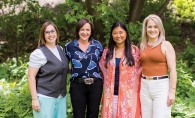
“In this moment in the world, where we try to understand people, it’s really nice to try to bridge this world by learning someone else’s language,” Cynthia Maldonado, principal of Nuevas Fronteras Spanish Immersion Elementary School, says. By learning another language, it helps people to try and understand another person’s perspectives and experiences; it also might change someone’s worldview.
That is why students at Nuevas Fronteras Spanish Immersion are becoming prepared to be global citizens through Spanish proficiency and cultural awareness. With more than 450 students, the elementary school serves students in kindergarten through fifth grade and is part of the South Washington Country Schools district.
Being one of 16 elementary schools in the district with a Spanish immersion program, Nuevas Fronteras is the just the start of South Washington Country Schools’ K–12 Spanish Immersion Pathway. The Pathway begins in elementary school, continues on at Woodbury Middle School and ends at Woodbury High School, where students complete two immersion classes a day: Spanish language arts and social studies. Once students reach high school, students can complete a capstone and, if eligible, can receive a bilingual seal on their diploma.
According to South Washington County Schools, Nuevas Fronteras has had quite the journey. The program began at Bailey Elementary School in 2003 and later moved to Crestview Elementary School. A grant from the Minnesota Department of Education supported the creation of immersion schools and provided funding to repurpose Oltman Middle School as Nuevas Fronteras. So, in 2015, the Woodbury community welcomed the repurposed building for a dedicated pathway school: Nuevas Fronteras.
Construction of Nuevas Fronteras didn’t begin until 2018, and ensured flexible learning spaces for teachers to provide students with personalized learning. Many classrooms in the school open up to larger learning spaces, and the school also has a media center that features a variety of workspaces for students. In addition, there are several devoted spaces for the arts and athletics, along with a 300-seat auditorium, art classroom and spaces for groups.
At the elementary school, students are fully immersed in the Spanish language while learning the same curriculum as traditional elementary schools. In the classroom, students learn about global cultures with teaching assistants from Latin America and Spain. (Though not all teachers are native-born speakers.) The teachers personalize learning for students by building relationships and they meet with each student before the start of the school year. With 20 classrooms and 25 teachers, students are not only taught by bilingual and certified speakers, but they develop better communication skills and gain awareness of other cultures.
Because of the school’s popularity among the Woodbury and surrounding communities, getting your student in the school can be somewhat challenging. “There are a lot of parents that don’t get in the first year. There’s always a waiting list,” says Maldonado. To make the admissions process fair, South Washington County Schools offer two programs: Multiage Choice and Spanish Immersion. Interested families apply for the programs and acceptance is determined by a lottery process. Maldonado says if future students continue to work on their Spanish, there generally are spaces that open up by lottery.
In the four years of being with the school, Maldonado has enjoyed every second. Reflecting on her students who are in the program, Maldonado says, “In immersion, they learn to read, write and speak in a second language. Often, they are more engaged about global issues because they are speaking another language; so, they’re more interested in Spanish speaking countries.”
Maldonado says this year and last has been different because of COVID-19, since students would typically celebrate cultural celebrations, including Día de Los Muertos (Day of the Dead), dance and sing in some classes.
But even through COVID-19, students are never without their community of peers and teachers who help them through their Spanish immersion journey. Maldonado says, “We want them to be bilingual, biliterate and bicultural in the fact that they’re very open to other cultures, are globally aware and that they can work in the current world.” She believes her students are more aware of the whole world by learning another language and, in doing so, it teaches them how to empathize with someone of another culture. “You really get to know who they are if you speak their language.”

Trey Edgerton, a 2014 Spanish Immersion Pathway graduate says, “I loved Spanish immersion. It was an experience like no other.” His most memorable experience was the annual Festival de las Culturas (Festival of Cultures), an end-of-the-year festival where students experience the different Spanish-speaking cultures intertwined through dance and poetry.
“Just being able to see the different influences and countries of Spanish speakers and how different their cultures are in one night, really speaks to the diversity within the Spanish speaking community,” Edgerton says, noting the event was also a great night for the community to experience.
Edgerton says the pathway program has been helpful in numerous ways, including on his study abroad trip to Spain in 2020. In addition to interacting with the local community, he says the community was impressed with his ability to navigate the country. “It gave me that sort of ease and feeling of security in a place I’ve never been to,” says Edgerton. Maldonado adds that each student in the pathway program is diligent and dedicated to the program—and she is excited for a long future with the pathway.









